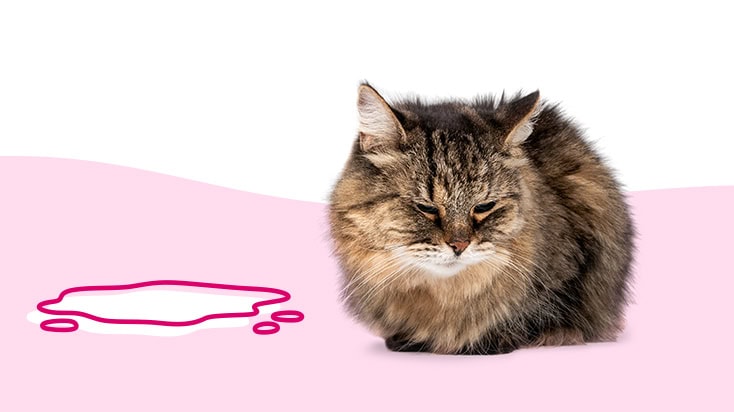Seeing your cat peeing blood can be frightening because cats do not normally have blood in their urine! Blood in a cat’s urine may indicate an underlying medical condition that may worsen without proper treatment.
In medical terms, bloody cat urine is called feline hematuria. It may occur for various reasons, but is usually a result of problems associated with your cat’s urinary tract. If your cat has blood in their urine, it warrants an immediate veterinarian visit, especially if your cat is also in pain.
Let’s look in more detail at what causes blood in cat urine.
1. Feline Idiopathic Cystitis
FIC, or Feline Idiopathic Cystitis, is a lower urinary tract disease that may cause urinary tract bleeding, resulting in blood in your cat’s urine. FIC causes inflammation of the protective lining of the urinary bladder, and the irritation can sometimes mean you find your cat peeing blood outside the litter box.
Although the symptoms are similar to bladder infections, FIC is not caused by bacteria or viruses, so it is not an infection. Its exact cause is unknown, but stress has been observed to trigger it. So, rearranging furniture, changing your cat’s diet, or even introducing a new pet can predispose your cat to FIC.
2. Urinary Tract Infections
UTIs or urinary tract infections are caused by bacterial infections in the bladder or urethra, leading to inflammation. This can result in bloody urine. Other signs of UTIs include difficulty urinating or producing significantly less urine than usual.
3. Kidney or Bladder Stones
Sometimes, cats develop kidney stones ( nephroliths) or bladder stones (cystoliths). Over time, these urinary stones grow so large that they obstruct normal urine flow. Additionally, they may pass into the ureters so that a cat develops complications like passing blood in urine. Kidney stones are more common in male cats and breeds like Persian and Siamese cats.
4. Bleeding or Clotting Disorders
Conditions that interfere with normal blood clotting can cause spontaneous bleeding, which can also lead to hematuria in cats. Bleeding or clotting disorders in cats can be genetic or develop later in life. Ingestion of toxins such as rat poison can also cause clotting disorders, which can show up as blood in a cat’s urine.
5. Blocked Urethra
A urethral blockage is a situation in which your pet can’t empty its bladder. A narrowing of the urethra, bladder stones, and cancer may cause this. Blocked urethrae are more common in male cats because they have narrower urethrae. This condition is a medical emergency, and a cat who is straining in the litter box but unable to pass urine (or very little urine, which could be bloody) should be seen by a veterinarian immediately.
6. Bladder Cancer
Bladder cancer may also explain the presence of blood in your cat’s urine. It can be aggressive and spread to other areas in the abdomen. If you have an older or elderly cat, blood in the urine is an important clinical sign to which you should pay attention. Other symptoms of bladder cancer include passing little or no urine, straining while peeing, and weight loss.
What to Do If Your Cat Has Bloody Urine
If your cat is peeing blood or seems in pain, like crying when peeing, it’s important to see a vet. It’s especially urgent if your cat has trouble urinating or can’t do so at all. Be alert to other changes too, such as variations in the volume or smell of the urine, unusual tiredness, frequent urination, excessive genital licking, or even blood in their stool.
Veterinarians will investigate blood in a cat’s urine through bloodwork, abdominal radiographs, ultrasound, and a physical examination. They also check the cat’s medical history and typical clinical signs of any possible underlying cause and assess the cat’s other symptoms.
Conclusion
The reasons for your cat peeing blood can vary widely, from a simple UTI to more intricate health concerns. It’s essential to get a professional opinion rather than making assumptions. If you’ve observed any unusual signs in your cat’s urine, consider booking an in-home vet visit. Your veterinarian will be able to diagnose hematuria in your cat, identify what caused it, and provide the best treatment options tailored to your pet’s situation.
Frequently Asked Questions
What does blood in cat urine look like?
You may notice pink urine rather than the usual color, as the blood and cat urine mix together in the bladder. Some urine even turns to a completely red hue.
Is blood in a cat’s urine an emergency?
If your cat is straining in the litter box, it could be an emergency and should be seen immediately. If you notice blood in the cat’s urine but they are acting normal, it isn’t considered an urgent medical emergency, but it is still significant enough not to ignore it. You should aim to get your cat assessed by a veterinarian within 24 hours.
Can a cat act normally with blood in their pee?
Yes, some cats with mild health issues may still act normal even if they are urinating blood. However, this doesn’t mean that they shouldn’t get checked. Even without severe pain, blood in the urine is still very concerning.
How do veterinarians treat bloody urine in cats?
The treatment depends on what condition or disease has caused the hematuria. For urinary infections, antibiotic therapy is usually needed. Your cat may require surgery and a special prescription diet for kidney stones or bladder stones, which can help dissolve certain types of stones. For other types, and depending on the size of the stone, surgery may be indicated.
How can I prevent my cat from having bloody urine?
Make sure your cat’s food is nutritionally complete and that they have unrestricted access to fresh water. Observe how much water they drink each day. Not drinking enough or lack of access to water can lead to dehydration, straining the urinary system.





